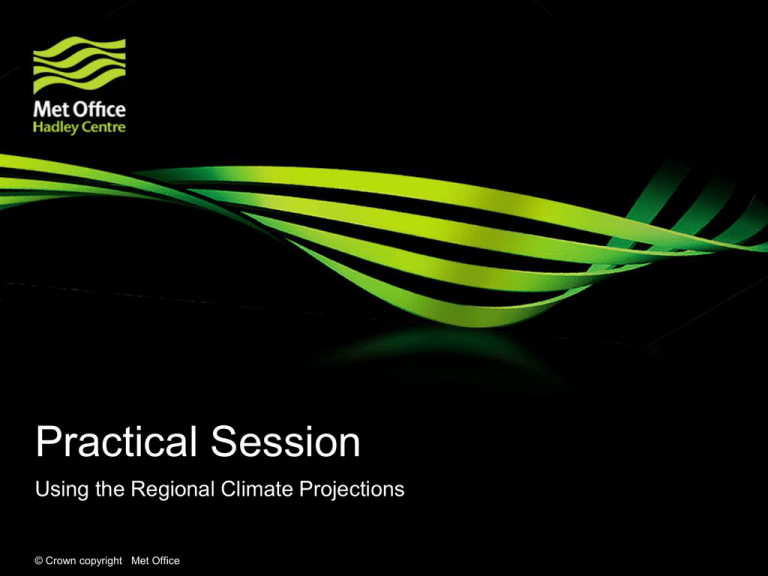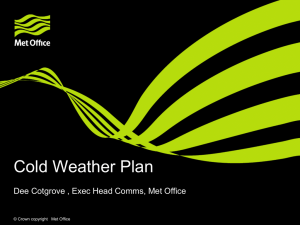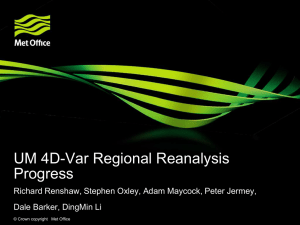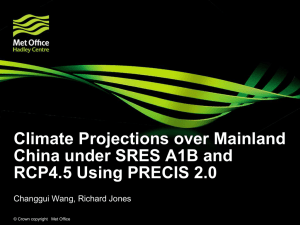National workshop on climate information and
advertisement

Practical Session Using the Regional Climate Projections © Crown copyright Met Office Aim of session To familiarise ourselves with the climate of West Africa, the RCM data, and learn about ways we can plot it, visualise it, and use it © Crown copyright Met Office Table of Contents • Installation of software • Plots of climate extremes: RClimDex • Free GIS and species modelling: DIVA-GIS © Crown copyright Met Office Installation of Software • Go to the PARCC folder • Under PARCC/Software double click: • R-2.15.3-win.exe • diva-gis_setup.exe • Follow installation instructions for each © Crown copyright Met Office DIVA GIS Visualising baseline data © Crown copyright Met Office Loading data • Open DIVA • Click the “+” button to add all layers from: PARCC/Data/GIS • This contains the following: • • • • Country boundaries Protected Areas RClimDex points Met Station Points from GSOD • Change the legend of the protected areas: • Double click on the layer • Under ‘Unique’ tab, select Field ‘iucn_cat’ • Click ‘ reset legend’, and choose colours for each class © Crown copyright Met Office Add Labels • • • • • © Crown copyright Met Office Select layer ‘rclimdex_points’ Go to Layer -> Add Labels Choose Field ‘name’ Set appropriate font Click ‘OK’ then ‘Close’ Add baseline climate data • Source: WorldClim climatic means for each month averaged over 1950-2000 at approx. 0.17 degree • Go to Tools -> Options • Click folder, and navigate to PARCC\Data\BaselineClimate\ • From dropdown select ‘worldclim_10m’ • Click ‘OK’ • Go to Data -> Climate -> Map • Match settings on right -> • Choose file, then click ‘Apply’ © Crown copyright Met Office Climate Extreme Indices RClimDex © Crown copyright Met Office RClimDex – What is it? A user friendly interface to compute indices of climate extremes Computes all 28 core indices recommended by the World Climate Research Programme for Climate Change Detection Monitoring and Indices Additionally other temperature and precipitation indices with user defined thresholds © Crown copyright Met Office Analysis of extremes • Wide range of space and time scales • From very small scale (precip) to large scale (droughts) • Extremes(GCM) ≠ Extremes(RCM) ≠ Extremes(Observed) • Definitions? • • • • High impact events Unprecedented events (in the available record) Rare events (long return periods) Exceedence of a relatively low threshold (indices, such as 10th percentile of daily temperature or 95th percentile of daily precipitation amounts) • Persistence of weather conditions (droughts) • Climatic extremes (e.g. extreme seasons) © Crown copyright Met Office CCl/CLIVAR/JCOMM Expert Team on Climate Change Detection and Indices (ETCCDI) from ETCCDI: • Definition of 28 core extreme indices • Organization of regional workshop • WMO-guide on extremes, 2009, targeted at NMHSs around the world http://www.wmo.int/datastat/docume nts/WCDMP_72_TD_1500_en_1 _1.pdf Running RClimDex • Make a note of the full path to your PARCC folder • E.g. C:/Users/precis/Desktop/PARCC/PARCC • Open R • Change directory to PARCC/Software >setwd(“C:/Users/precis/Desktop/PARCC/PARCC/PARCC/ Software”) • Run the script > source(“rclimdex.r”) © Crown copyright Met Office Loading data • Click “Load Data and Run QC” • Navigate to: PARCC\Practical\RClimDex\HadCM3-Q0_PRECIS • Load “River Gambia National Park.txt”. This is the daily RCM data (1949-2099) extracted for the area surrounding River Gambia National Park • Click OK • Under “Set Parameters for Data QC”, change to 5 standard deviations © Crown copyright Met Office Loading data • Click OK to 3 subsequent messages • These are alerts for the detection of outliers in station observations • Check “PARCC/Practical/RClimDex/ HadCM3-Q0_PRECIS/log/ River Gambia National Park_tepstdQC.csv” • These events are excluded from the analysis © Crown copyright Met Office What has RClimDex done? • Check back in the directory: • “PARCC/Practical/RClimDex/HadCM3-Q0_PRECIS” • RClimDex created new directories • Check “log” directory • What does this contain? © Crown copyright Met Office Indices Calculation • Data is now loaded into memory • Click “Indices Calculation”, and enter the following settings © Crown copyright Met Office Indices Calculation • Next, keep all variables checked, and click OK © Crown copyright Met Office Indices Calculation • After several minutes, a completion message will appear • Check the “plots” folder • Use the handout to identify variables • Which variables could be useful to species in your country? © Crown copyright Met Office Next steps • Review thresholds • Consider other ensemble members and other locations • All indices have been calculated. Check ... © Crown copyright Met Office Interpretation • Pay attention to scales on y-axis • Years between 1950-2100 on x-axis • 1 data point per year Goodness of fit R2 = measure of how well the regression line fits the data points. High value = good fit p-value < 0.05 means that there is a significant relationship between the trend and the data points © Crown copyright Met Office Trend lines Linear regression (best fit) Loess smoothing Interpretation CAUTION! If the p-value is > 0.05 we cannot be confident that the trend is significant © Crown copyright Met Office Comparing plots • Climate as 30 year average • Natural variability • Extreme outliers • Decadal variability may go against long term trend © Crown copyright Met Office Quiz Questions! Tip: if using Windows 7, the search function is very good! When in the directory PARCC/Data/RClimDex , try searching for “river gambia PRCPTOT jpg” 1. In River Gambia National Park, how would you describe the projections for change in total precipitation for the climate of the: a. b. 2040s? 2080s? 2. In Baobolong and Kiang West, look at maximum number of consecutive wet days (CWD) between 1950-2000. For each ensemble member: a. b. What is the average number of CWD? What is the range? 3. For Q0, which park has no significant trend in Daily Temperature Range? 4. Which other ensemble members have no trend in DTR for that park? © Crown copyright Met Office Quiz Answers! 1. In River Gambia National Park, how would you describe the projections for change in total precipitation for the climate of the: a. b. 2040s? Slight decrease, although most ensemble members show little change outside of natural variability 2080s? Significant decreases in all models of approximately 100m per year 2. In Bbaobolon and Kiang West, look at maximum number of consecutive wet days (CWD) between 1950-2000. For each ensemble member: a. b. What is the average number of CWD? 11, 11, 9, 9, 9 What is the range? 6-34, 3-22, 4-20, 5-18, 5-14 3. For Q0, which park has no significant trend in Daily Temperature Range? Tanbi NP 4. Which other ensemble members have no trend for that park? All of them (Q0, Q2, Q9, Q13, Q14) © Crown copyright Met Office Thank you! © Crown copyright Met Office










